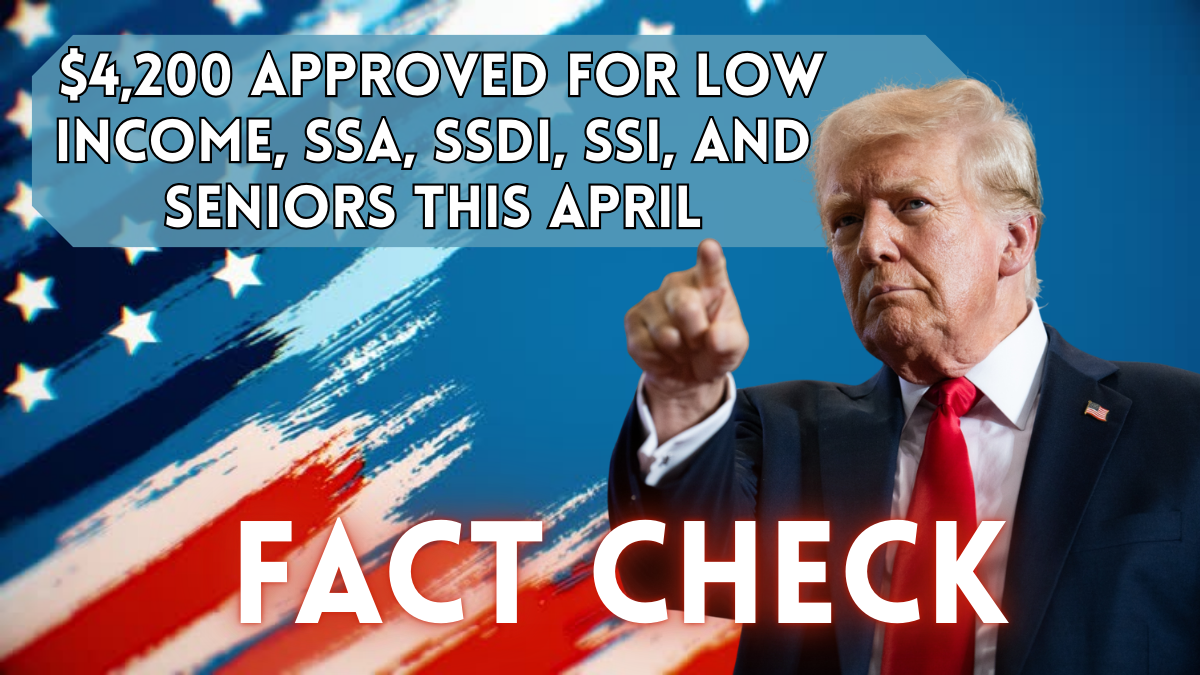$4,200 Approved This Month for Low Income, SSA, SSDI, SSI, and Seniors in April—Fact Check
Over the previous couple of months, there has been a terrific deal of interest in low-income economic aid applications, inclusive of Social Security beneficiaries, Supplemental Security Income (SSI) beneficiaries, and Supplemental Security Disability Insurance (SSDI) beneficiaries. The April 2025 rumor that $4,200 is being approved for these beneficiaries has been circulating in the news. While these rumors might be giving hope to those who are eligible, it’s always better to check facts to know what is really being provided, to whom, and what precisely is being called by this $4,200.
This article will detail the most substantial financial programs in April 2025, explain how to qualify for each, and lay to rest how much you will actually receive, dispelling the myth regarding the $4,200 amount.
Overview of Financial Support for Low-Income Groups
There are a few government programs in 2025 that will pay money to those with low incomes or disabilities. They are Social Security benefits (SSA), Supplemental Security Income (SSI), and Supplemental Security Disability Insurance (SSDI). There are also a few more programs like the Cost of Living Payments and state-specific assistance for elderly and low-income individuals. The idea of a $4,200 windfall this month is probably the compilation of a variety of disparate payments or increases of money provided by these various different systems of aid.
Social Security Benefits (SSA)
Social Security is one of the biggest programs that pays retired workers, the disabled, and survivors of workers who have died. For most, these payments are an important source of income.
April 2025 SSA Payment
In 2025, Social Security beneficiaries draw regular monthly bills based totally on their pay once they have been employed. The regular monthly Social Security pension for retired employees is now $1,800, as of the trendy available information. For SSDI recipients, the monthly price is generally lower, averaging perhaps approximately $1,400.
But the $4,200 quoted on the web is not a sum of these usual monthly payments. Rather, it’s probably being confused with some other one-time payments or yearly payments.
Yearly Increases
Perhaps the most sizable aspect of Social Security blessings is the cost-of-residing adjustment (COLA), which is designed to keep pace with inflation. In 2025, an 8.7% COLA boost brought Social Security blessings, resulting in a massive increase in payments across the board.
- For retirees, that means a growth in monthly advantages, with the average monthly benefit growing to about $1,900.
- SSDI and SSI recipients additionally get the same raise, elevating their monthly payments.
While these increases can substantially boost the financial position of beneficiaries, the yearly total payout for someone taking Social Security is far from $4,200 a month unless they worked and earned much higher pay over their lifetime.
Supplemental Security Income (SSI)

SSI is a Social Security Administration (SSA) program. SSI makes payments to aged, blind, and disabled people who have limited resources and income.
SSI Payments in 2025
The federal government raised the maximum SSI fee for 2025 to $914 per month for an individual and $1,371 per month for couples. The amount you get can rely on where you live, your profits, and other factors. Some states give supplements to SSI recipients, boosting the whole amount of the benefit; however, even inclusive of the ones with dietary supplements, nobody receiving SSI is now getting $4,200 a month.
The $4,200 assertion is probably a misreading or misstatement of several payments totaled together.
Supplemental Security Disability Insurance (SSDI)
SSDI makes payments to people who have a qualifying incapacity and have labored long enough in the past to have paid into the Social Security gadget. Unlike SSI, SSDI is not based totally on want but on a person’s work records.
SSDI Payments in 2025
In April of 2025, SSDI recipients are seeing an 8.7% increase in their monthly advantage, a big one, to deliver their checks into alignment with what retirees and SSI recipients are seeing. But as of 2025, the average month-to-month SSDI advantage is inside the ballpark of $1,400. Some will have worked their whole working lives and contributed more to Social Security through taxes, but even they will see hardly more than $4,200 a month.
The $4,200 Figure: What Does It Mean?
The $4,200 is probably multiple payments added together or an error in the annual figure instead of monthly payments. There are a number of possible reasons for this error:
- Annual Payment Breakdown:
If you combine diverse blessings in 12 months, like your month-to-month Social Security gain, cost of living will increase, and other special or lump-sum bills, you could find yourself with a total of over $4,200 in a span of 365 days. For example, in case you have become $1,900 a month (after the COLA growth), that translates to $22,800 over 12 months, over $4,200. - One-Off or Special Payments:
Sometimes the government makes special one-off payments to assist individuals who have particular requirements, like cost-of-living payments or stimulus checks. These payments usually are distinct from standard monthly payments and may enhance total financial help in a month above normal rates but not up to $4,200, except if you count a variety of other benefits. - The Payments Misunderstanding:
The other possibility is that the $4,200 is a cumulative figure of monthly Social Security payments, yearly COLA boosts, and any supplemental payments like the Senior Cost of Living Payment or Stimulus Payments. These lump sums can become very large when combined.
Further Support Available in April 2025
Besides SSA, SSDI, and SSI benefits, several other forms of financial support are available in 2025 that could contribute to the $4,200 total:
Cost of Living Payment (2025)
The UK authorities’ Cost of Living Payment scheme offers as much as £300 in single payments to claimants on means-tested benefits, including Universal Credit or Pension Credit. This isn’t exactly a comparison with the U.S. authorities; however, there are similar schemes in the U.S. that are meant to help people with low incomes with the cost of dwelling rises. The payments can be added on top of the total financial assistance that individuals can claim, although not every person claiming the benefits can claim on top of this.
Who is Eligible for Financial Support?

Applicants must meet some criteria of eligibility in order to be eligible for the above types of assistance, and these are established by the following factors:
- Income level (for SSDI and SSI)
- Disability status (for SSDI beneficiaries)
- Employment history (for recipients of SSDI) – Age (for Social Security retirement benefits) – Residential arrangements (for SSI) Those who want to maximize their aid should also determine if they qualify for additional aid through state programs, local grants, or other federal programs.
Conclusion
That $4,200 figure that’s being bandied about is likely a total of many various payments and benefits, including perhaps Social Security, SSI, SSDI, and one-time cost-of-living programs. While these benefits are up in 2025 through the annual cost-of-living adjustments, it’s helpful to know that $4,200 is not an average monthly benefit amount for low-income recipients or seniors on Social Security or disability payments.
Instead, the increase in aid is through greater monthly payments, one-time cost-of-living payouts, and other forms of government aid that can bring total aid over a period of several months into higher figures. If you’re struggling to pay bills or living expenses, be sure to take advantage of all relevant programs and look into new government programs aimed at giving economic aid to those in need.
FAQs
What is the $4,200 claim for low-income groups in April 2025?
The $4,200 claim likely misrepresents multiple payments combined, including Social Security, SSDI, SSI, and other government benefits.
What are the main government programs providing assistance in April 2025?
Social Security (SSA), SSDI, SSI, and additional programs like Cost of Living Payments offer financial support for low-income individuals.
What is the average monthly payment for Social Security recipients in 2025?
In 2025, the average monthly Social Security payment for retirees is around $1,900, after the COLA increase.



